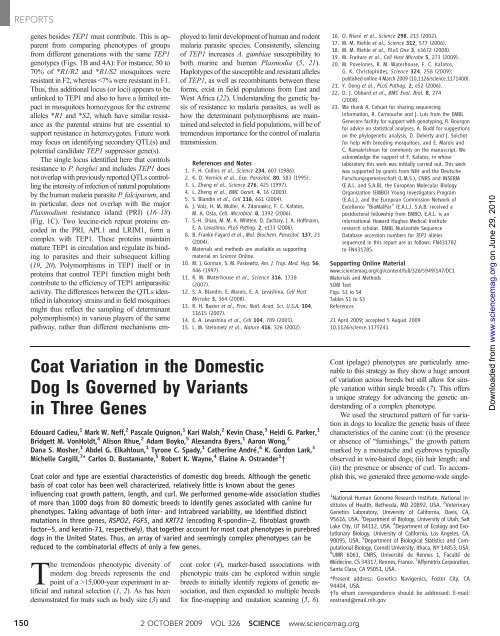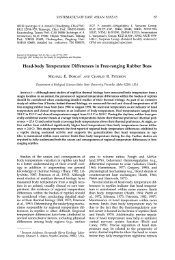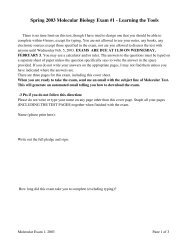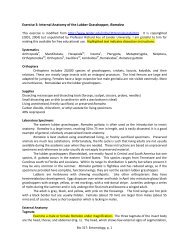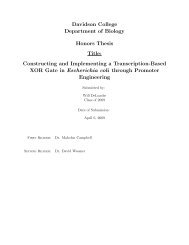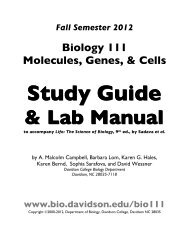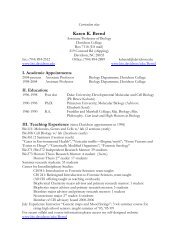Coat Variation in the Domestic Dog is Governed - Biology @ Davidson
Coat Variation in the Domestic Dog is Governed - Biology @ Davidson
Coat Variation in the Domestic Dog is Governed - Biology @ Davidson
You also want an ePaper? Increase the reach of your titles
YUMPU automatically turns print PDFs into web optimized ePapers that Google loves.
REPORTS<br />
150<br />
genes besides TEP1 must contribute. Th<strong>is</strong> <strong>is</strong> apparent<br />
from compar<strong>in</strong>g phenotypes of groups<br />
from different generations with <strong>the</strong> same TEP1<br />
genotypes (Figs. 1B and 4A): For <strong>in</strong>stance, 50 to<br />
70% of *R1/R2 and *R1/S2 mosquitoes were<br />
res<strong>is</strong>tant <strong>in</strong> F2, whereas 15,000-year experiment <strong>in</strong> artificial<br />
and natural selection (1, 2). As has been<br />
demonstrated for traits such as body size (3) and<br />
coat color (4), marker-based associations with<br />
phenotypic traits can be explored with<strong>in</strong> s<strong>in</strong>gle<br />
breeds to <strong>in</strong>itially identify regions of genetic association,<br />
and <strong>the</strong>n expanded to multiple breeds<br />
for f<strong>in</strong>e-mapp<strong>in</strong>g and mutation scann<strong>in</strong>g (5, 6).<br />
2 OCTOBER 2009 VOL 326 SCIENCE www.sciencemag.org<br />
16. O. Niaré et al., Science 298, 213 (2002).<br />
17. M. M. Riehle et al., Science 312, 577 (2006).<br />
18. M. M. Riehle et al., PLoS One 3, e3672 (2008).<br />
19. M. Fraiture et al., Cell Host Microbe 5, 273 (2009).<br />
20. M.Povelones,R.M.Waterhouse,F.C.Kafatos,<br />
G. K. Chr<strong>is</strong>tophides, Science 324, 258 (2009);<br />
publ<strong>is</strong>hed onl<strong>in</strong>e 4 March 2009 (10.1126/science.1171400).<br />
21. Y. Dong et al., PLoS Pathog. 2, e52 (2006).<br />
22. D. J. Obbard et al., BMC Evol. Biol. 8, 274<br />
(2008).<br />
23. We thank A. Cohuet for shar<strong>in</strong>g sequenc<strong>in</strong>g<br />
<strong>in</strong>formation, R. Carmouche and J. Lu<strong>is</strong> from <strong>the</strong> EMBL<br />
Genecore facility for support with genotyp<strong>in</strong>g, R. Bourgon<br />
for advice on stat<strong>is</strong>tical analyses, A. Budd for suggestions<br />
on <strong>the</strong> phylogenetic analys<strong>is</strong>, D. Doherty and J. Soichot<br />
for help with breed<strong>in</strong>g mosquitoes, and E. Maro<strong>is</strong> and<br />
C. Ramakr<strong>is</strong>hnan for comments on <strong>the</strong> manuscript. We<br />
acknowledge <strong>the</strong> support of F. Kafatos, <strong>in</strong> whose<br />
laboratory th<strong>is</strong> work was <strong>in</strong>itially carried out. Th<strong>is</strong> work<br />
was supported by grants from NIH and <strong>the</strong> Deutsche<br />
Forschungsgeme<strong>in</strong>schaft (L.M.S.), CNRS and INSERM<br />
(E.A.L. and S.A.B), <strong>the</strong> European Molecular <strong>Biology</strong><br />
Organization (EMBO) Young Investigators Program<br />
(E.A.L.), and <strong>the</strong> European Comm<strong>is</strong>sion Network of<br />
Excellence “BioMalPar” (E.A.L.). S.A.B. received a<br />
postdoctoral fellowship from EMBO. E.A.L. <strong>is</strong> an<br />
<strong>in</strong>ternational Howard Hughes Medical Institute<br />
research scholar. EMBL Nucleotide Sequence<br />
Database accession numbers for TEP1 alleles<br />
sequenced <strong>in</strong> th<strong>is</strong> report are as follows: FN431782<br />
to FN431785.<br />
Support<strong>in</strong>g Onl<strong>in</strong>e Material<br />
www.sciencemag.org/cgi/content/full/326/5949/147/DC1<br />
Materials and Methods<br />
SOM Text<br />
Figs. S1 to S4<br />
Tables S1 to S3<br />
References<br />
21 April 2009; accepted 5 August 2009<br />
10.1126/science.1175241<br />
<strong>Coat</strong> (pelage) phenotypes are particularly amenable<br />
to th<strong>is</strong> strategy as <strong>the</strong>y show a huge amount<br />
of variation across breeds but still allow for simple<br />
variation with<strong>in</strong> s<strong>in</strong>gle breeds (7). Th<strong>is</strong> offers<br />
a unique strategy for advanc<strong>in</strong>g <strong>the</strong> genetic understand<strong>in</strong>g<br />
of a complex phenotype.<br />
We used <strong>the</strong> structured pattern of fur variation<br />
<strong>in</strong> dogs to localize <strong>the</strong> genetic bas<strong>is</strong> of three<br />
character<strong>is</strong>tics of <strong>the</strong> can<strong>in</strong>e coat: (i) <strong>the</strong> presence<br />
or absence of “furn<strong>is</strong>h<strong>in</strong>gs,” <strong>the</strong> growth pattern<br />
marked by a moustache and eyebrows typically<br />
observed <strong>in</strong> wire-haired dogs; (ii) hair length; and<br />
(iii) <strong>the</strong> presence or absence of curl. To accompl<strong>is</strong>h<br />
th<strong>is</strong>, we generated three genome-wide s<strong>in</strong>gle-<br />
1<br />
National Human Genome Research Institute, National Institutes<br />
of Health, Be<strong>the</strong>sda, MD 20892, USA. 2 Veter<strong>in</strong>ary<br />
Genetics Laboratory, University of California, Dav<strong>is</strong>, CA,<br />
95616, USA. 3 Department of <strong>Biology</strong>, University of Utah, Salt<br />
Lake City, UT 84112, USA. 4 Department of Ecology and Evolutionary<br />
<strong>Biology</strong>, University of California, Los Angeles, CA,<br />
90095, USA. 5 Department of Biological Stat<strong>is</strong>tics and Computational<br />
<strong>Biology</strong>, Cornell University, Ithaca, NY 14853, USA.<br />
6<br />
UMR 6061, CNRS, Université de Rennes 1, Faculté de<br />
Médec<strong>in</strong>e, CS 34317, Rennes, France. 7 Affymetrix Corporation,<br />
SantaClara,CA95051,USA.<br />
*Present address: Genetics Navigenics, Foster City, CA<br />
94404, USA.<br />
†To whom correspondence should be addressed. E-mail:<br />
eostrand@mail.nih.gov<br />
on June 29, 2010<br />
www.sciencemag.org<br />
Downloaded from
nucleotide polymorph<strong>is</strong>m (SNP) data sets us<strong>in</strong>g<br />
<strong>the</strong> Affymetrix version 2.0 can<strong>in</strong>e SNP chip (8, 9).<br />
The first data set cons<strong>is</strong>ted of 96 dachshunds segregat<strong>in</strong>g<br />
three coat varieties: wire-haired with<br />
furn<strong>is</strong>h<strong>in</strong>gs, smooth, and long-haired without furn<strong>is</strong>h<strong>in</strong>gs.<br />
The second data set compr<strong>is</strong>ed 76 Portuguese<br />
water dogs (PWDs), segregat<strong>in</strong>g <strong>the</strong> curl<br />
phenotype. The f<strong>in</strong>al data set, termed CanMap,<br />
<strong>in</strong>cluded 903 dogs from 80 breeds represent<strong>in</strong>g a<br />
wide variety of phenotypes. An additional data<br />
set used to map furn<strong>is</strong>h<strong>in</strong>gs <strong>in</strong>cluded a panel of<br />
microsatellite markers (10), genotyped on a 96dachshund<br />
pedigree segregat<strong>in</strong>g all three coat<br />
varieties.<br />
The same strategy was used to map all three<br />
traits. First, a genome-wide association study<br />
(GWAS) with<strong>in</strong> a breed segregat<strong>in</strong>g <strong>the</strong> phenotype<br />
was conducted to determ<strong>in</strong>e <strong>the</strong> most strongly<br />
associated locus. To rule out false-positives<br />
caused by population structure with<strong>in</strong> <strong>the</strong> breeds<br />
(11), we did a second GWAS that used <strong>the</strong><br />
CanMap data set divided <strong>in</strong>to cases and controls<br />
A<br />
B<br />
-log 10 (pval)<br />
C<br />
-log 10 (pval)<br />
D<br />
25<br />
20<br />
15<br />
10<br />
5<br />
250<br />
200<br />
150<br />
100<br />
50<br />
1<br />
1<br />
based on <strong>the</strong> presence or absence of <strong>the</strong> phenotype<br />
<strong>in</strong> question. F<strong>in</strong>e-mapp<strong>in</strong>g of significant,<br />
concordant peaks was used to def<strong>in</strong>e <strong>the</strong> smallest<br />
shared haplotype, followed by sequenc<strong>in</strong>g to identify<br />
<strong>the</strong> putative causative mutations. Each mutation<br />
was validated <strong>in</strong> a large panel of at least<br />
661 dogs from 108 breeds, <strong>in</strong>clud<strong>in</strong>g cases and<br />
controls for all phenotypes (table S1).<br />
We <strong>in</strong>itially mapped furn<strong>is</strong>h<strong>in</strong>gs <strong>in</strong> <strong>the</strong> dachshund<br />
us<strong>in</strong>g smooth-coated and long-haired dogs<br />
as controls and wire-haired dogs as cases (Fig.<br />
1A). S<strong>in</strong>gle-marker analys<strong>is</strong> of <strong>the</strong> dachshund<br />
GWAS data set and concurrent l<strong>in</strong>kage analys<strong>is</strong><br />
of <strong>the</strong> dachshund pedigree identified <strong>the</strong> same<br />
locus on can<strong>in</strong>e chromosome 13 (CFA13) surround<strong>in</strong>g<br />
nucleotide 11,095,120 [P =3.4×10 −27 ,<br />
lod score (logarithm of <strong>the</strong> odds ratio for l<strong>in</strong>kage) =<br />
5.6; Fig. 1B]. We confirmed <strong>the</strong> association on<br />
CFA13 <strong>in</strong> <strong>the</strong> CanMap data set at nucleotide<br />
11,659,792 (P =10 −241 ; Fig. 1C and table S2).<br />
A 718-kb homozygous haplotype <strong>in</strong> all dogs<br />
fixed with furn<strong>is</strong>h<strong>in</strong>gs was located with<strong>in</strong> both<br />
- Chr13: 10000000 10500000 11000000 11500000 12000000 12500000 13000000 13500000<br />
- Dachshund dataset<br />
- Multibreed dataset<br />
- SNPlex dataset<br />
- Non-<strong>Dog</strong><br />
RefSeq<br />
Genes<br />
5<br />
5<br />
Smooth-coated, Long-haired and Wire-haired Dachshunds<br />
OXR1<br />
10 13 15<br />
20<br />
25 30 3538 X<br />
10 13 15<br />
20<br />
25 30 3538 X<br />
ANGPT1<br />
ABRA<br />
SF3A3<br />
ALDH2<br />
718 Kb<br />
238 Kb<br />
<strong>in</strong>del<br />
RSPO2<br />
EIF3E<br />
TTC35<br />
HSP90AB1<br />
TMEM74<br />
PKHD1L1 CETN2 BID<br />
BTG3 EBAG9 KCNV1<br />
TRHR GOLSYN<br />
NUDCD1<br />
3.4 Mb<br />
Fig. 1. GWAS and f<strong>in</strong>e-mapp<strong>in</strong>g identify RSPO2 as<strong>the</strong>associatedgeneformoustacheandeyebrow<br />
growth pattern (furn<strong>is</strong>h<strong>in</strong>gs). (A) Three types of coat segregate <strong>in</strong> dachshunds: (from left to right) smoothcoated,<br />
long-haired, and wire-haired with furn<strong>is</strong>h<strong>in</strong>gs. (B) Results of <strong>the</strong> GWAS <strong>in</strong> <strong>the</strong> dachshund us<strong>in</strong>g<br />
wire-haired dogs as cases and smooth-coated and long-haired dogs as controls. The best P value (3.35 ×<br />
10 −27 ), highlighted by <strong>the</strong> arrow, <strong>is</strong> located on CFA13 at position 11,095,120. (C) Results of <strong>the</strong> GWAS for<br />
furn<strong>is</strong>h<strong>in</strong>gs <strong>in</strong> <strong>the</strong> CanMap data set. The arrow highlights <strong>the</strong> best association (P =10 −241 )atCFA13<br />
position 11,659,792. Both P values were obta<strong>in</strong>ed with s<strong>in</strong>gle-marker c 2 analyses. (D) Homozygous regions<br />
identified <strong>in</strong> cases from GWAS and f<strong>in</strong>e-mapp<strong>in</strong>g. The red rectangle represents <strong>the</strong> associated haplotype <strong>in</strong><br />
<strong>the</strong> dachshund; <strong>the</strong> blue rectangle spans <strong>the</strong> homozygous region from 19 breeds fixed for furn<strong>is</strong>h<strong>in</strong>gs<br />
based on <strong>the</strong> multibreed data set; <strong>the</strong> green rectangle <strong>in</strong>dicates <strong>the</strong> region of homozygosity <strong>in</strong> 18 breeds<br />
fixed for <strong>the</strong> furn<strong>is</strong>h<strong>in</strong>gs after f<strong>in</strong>e-mapp<strong>in</strong>g. A 167-bp deletion, <strong>in</strong>dicated by <strong>the</strong> small red rectangle, <strong>is</strong><br />
located with<strong>in</strong> all three haplotypes <strong>in</strong> <strong>the</strong> 3′UTR of <strong>the</strong> RSPO2 gene. The positions of genes <strong>in</strong> <strong>the</strong> region<br />
are represented by open boxes at <strong>the</strong> bottom of <strong>the</strong> figure, labeled to <strong>the</strong> left, with arrows <strong>in</strong>dicat<strong>in</strong>g<br />
read<strong>in</strong>g-frame direction (www.genome.ucsc.edu).<br />
REPORTS<br />
<strong>the</strong> orig<strong>in</strong>al 3.4-Mb haplotype observed <strong>in</strong> <strong>the</strong><br />
dachshund-only GWAS, and a 2.8-Mb haplotype<br />
identified <strong>in</strong> crossover analys<strong>is</strong> with<strong>in</strong> <strong>the</strong><br />
dachshund pedigree (Fig. 1D).<br />
F<strong>in</strong>e-mapp<strong>in</strong>g allowed us to reduce <strong>the</strong><br />
homozygous region to 238 kb spann<strong>in</strong>g only<br />
<strong>the</strong> R-spond<strong>in</strong>–2 (RSPO2) gene, exclud<strong>in</strong>g <strong>the</strong><br />
5´ untranslated region (5′UTR) and <strong>the</strong> first<br />
exon (Fig. 1D, fig. S1, and table S3). RSPO2 <strong>is</strong><br />
an excellent candidate for a hair-growth phenotype<br />
as it synergizes with Wnt to activate bcaten<strong>in</strong><br />
(12), and Wnt signal<strong>in</strong>g <strong>is</strong> required for<br />
<strong>the</strong> establ<strong>is</strong>hment of <strong>the</strong> hair follicles (13, 14).<br />
Moreover, <strong>the</strong> Wnt/b-caten<strong>in</strong> pathway <strong>is</strong> <strong>in</strong>volved<br />
<strong>in</strong> <strong>the</strong> development of hair-follicle tumors, or pilomatricomas<br />
(15), which occur most frequently <strong>in</strong><br />
breeds that have furn<strong>is</strong>h<strong>in</strong>gs (16). Recent studies<br />
have shown that a mutation <strong>in</strong> <strong>the</strong> EDAR gene,<br />
also <strong>in</strong>volved <strong>in</strong> <strong>the</strong> Wnt pathway, <strong>is</strong> responsible<br />
for a coarse East-Asian hair type found <strong>in</strong> humans<br />
(17), with some similarity to can<strong>in</strong>e wirehair.<br />
All exons and conserved regions of RSPO2<br />
were sequenced <strong>in</strong> dogs from seven breeds (table<br />
S4). Only an <strong>in</strong>sertion of 167 base pairs (bp)<br />
with<strong>in</strong> <strong>the</strong> 3′UTR at position 11,634,766 was<br />
perfectly associated with <strong>the</strong> furn<strong>is</strong>h<strong>in</strong>gs trait <strong>in</strong><br />
dogs from both <strong>the</strong> case/control study and <strong>the</strong> extended<br />
pedigree (table S5). The result was fur<strong>the</strong>r<br />
confirmed <strong>in</strong> a set of 704 dogs of vary<strong>in</strong>g phenotypes.<br />
In total, 297 of 298 dogs with furn<strong>is</strong>h<strong>in</strong>gs<br />
were ei<strong>the</strong>r homozygous (268) or heterozygous<br />
(29) for <strong>the</strong> <strong>in</strong>sertion, and all 406 dogs lack<strong>in</strong>g<br />
<strong>the</strong> trait were homozygous for <strong>the</strong> ancestral state,<br />
as <strong>is</strong> cons<strong>is</strong>tent with a dom<strong>in</strong>ant mode of <strong>in</strong>heritance<br />
(table S1).<br />
Th<strong>is</strong> mutation does not affect <strong>the</strong> prote<strong>in</strong>cod<strong>in</strong>g<br />
region of <strong>the</strong> RSPO2 gene. However, because<br />
<strong>the</strong> 3′UTR frequently encodes elements<br />
that <strong>in</strong>fluence mRNA stability [reviewed <strong>in</strong> (18)],<br />
we exam<strong>in</strong>ed whe<strong>the</strong>r <strong>the</strong> <strong>in</strong>sertion was associated<br />
with a change <strong>in</strong> <strong>the</strong> expression level of <strong>the</strong><br />
RSPO2 gene. We found a threefold <strong>in</strong>crease <strong>in</strong><br />
RSPO2 transcripts <strong>in</strong> muzzle sk<strong>in</strong> biopsies of dogs<br />
with furn<strong>is</strong>h<strong>in</strong>gs, cons<strong>is</strong>tent with a transcript effect<br />
(fig. S2).<br />
We applied <strong>the</strong> same mapp<strong>in</strong>g strategy to<br />
hair length. Previously, mutations <strong>in</strong> <strong>the</strong> FGF5<br />
gene were identified <strong>in</strong> Welsh corg<strong>is</strong> segregat<strong>in</strong>g<br />
an atypical “fluffy” or long-haired phenotype (19)<br />
and associated with excess hair growth <strong>in</strong> mice<br />
and cats (20–22). Our study replicates <strong>the</strong>se f<strong>in</strong>d<strong>in</strong>gs<br />
<strong>in</strong> an extended breed set. Indeed, association<br />
analyses <strong>in</strong> both <strong>the</strong> dachshund and CanMap data<br />
sets highlight <strong>the</strong> region on CFA32 conta<strong>in</strong><strong>in</strong>g<br />
FGF5 with P values of 3 × 10 −27 and 9 × 10 −44 ,<br />
respectively. After f<strong>in</strong>e-mapp<strong>in</strong>g, a 67-kb homozygous<br />
region highlighted <strong>the</strong> FGF5 gene (Fig.<br />
2A, fig. S3, and table S6). The strongest association<br />
was observed at position 7,473,337 (P =<br />
1×10 −157 ), <strong>in</strong> which a highly conserved Cys<br />
<strong>is</strong> changed to Phe (Cys 95 →Phe) <strong>in</strong> exon 1 of<br />
FGF5, cons<strong>is</strong>tent with <strong>the</strong> previous study (19).<br />
Sequenc<strong>in</strong>g with<strong>in</strong> <strong>the</strong> homozygous haplotype<br />
revealed no SNPs with stronger association<br />
(table S7).<br />
www.sciencemag.org SCIENCE VOL 326 2 OCTOBER 2009 151<br />
on June 29, 2010<br />
www.sciencemag.org<br />
Downloaded from
REPORTS<br />
152<br />
A<br />
B<br />
C<br />
- Chr32: 7450000 7550000 7650000 7750000 7850000 7950000<br />
- Dachshund dataset<br />
- Multibreed dataset<br />
- SNPlex dataset<br />
- Non-<strong>Dog</strong><br />
RefSeq PRDM8<br />
Genes<br />
125 Kb<br />
67 Kb<br />
best SNP<br />
FGF5<br />
C4orf22<br />
Curly-haired Portuguese Water <strong>Dog</strong> Wavy-haired Portuguese Water <strong>Dog</strong><br />
- Chr27: 5525000 5535000 5545000 5555000<br />
- SNPlex dataset<br />
- Ensembl Gene<br />
Predictions<br />
KRT74<br />
KRT71<br />
Best SNP from SNPlex<br />
Best SNP from Sequenc<strong>in</strong>g<br />
32 Kb<br />
520 Kb<br />
Fig. 2. Regions of homozygosity identify genes for pelage length and curl. (A) Homozygous region<br />
found on CFA32 def<strong>in</strong><strong>in</strong>g <strong>the</strong> length locus. The red bar <strong>in</strong>dicates <strong>the</strong> 520-kb associated haplotype<br />
from 29 long-haired dachshunds; <strong>the</strong> blue bar spans <strong>the</strong> 125-kb homozygous region found <strong>in</strong> 319<br />
dogs from 31 long-haired breeds; <strong>the</strong> green bar represents <strong>the</strong> 67-kb reduced homozygous region<br />
found after f<strong>in</strong>e-mapp<strong>in</strong>g <strong>in</strong> 293 dogs from 39 long-haired breeds. The best-associated SNP,<br />
represented by <strong>the</strong> small red rectangle, <strong>is</strong> with<strong>in</strong> <strong>the</strong>se three homozygous regions <strong>in</strong> exon 1 of <strong>the</strong><br />
FGF5 gene. (B) PWDs d<strong>is</strong>play two coat varieties: curly (two left panels) and wavy (two right panels).<br />
(C) Haplotype analys<strong>is</strong> at <strong>the</strong> curl locus on CFA27. The green bar represents <strong>the</strong> 32-kb homozygous<br />
haplotype found after f<strong>in</strong>e-mapp<strong>in</strong>g <strong>in</strong> 65 dogs from five curly haired breeds. The best-associated<br />
SNP, represented by <strong>the</strong> small red rectangle, was found with<strong>in</strong> <strong>the</strong> homozygous haplotype <strong>in</strong> exon 2<br />
of <strong>the</strong> KRT71 gene. The positions of genes <strong>in</strong> both regions (A and C) are represented by open boxes<br />
at <strong>the</strong> bottom of each figure, labeled to <strong>the</strong> left, with arrows <strong>in</strong>dicat<strong>in</strong>g read<strong>in</strong>g-frame direction<br />
(www.genome.ucsc.edu). Curly PWD photos courtesy of M. Bloom (Copyright AKC).<br />
A<br />
B<br />
C<br />
D<br />
E<br />
F<br />
G<br />
A Basset Hound B Australian Terrier<br />
D Golden Retriever<br />
F Ir<strong>is</strong>h Water Spaniel<br />
C Airedale Terrier<br />
E Bearded Collie<br />
G Bichon Fr<strong>is</strong>é<br />
Fig. 3. Comb<strong>in</strong>ations of alleles at three genes create seven different coat phenotypes. Plus (+) and<br />
m<strong>in</strong>us signs (−) <strong>in</strong>dicate <strong>the</strong> presence or absence of variant (nonancestral) genotype. A character<strong>is</strong>tic<br />
breed <strong>is</strong> represented for each of <strong>the</strong> seven comb<strong>in</strong>ations observed <strong>in</strong> our data set: (A) short hair; (B)<br />
wire hair; (C) “curly-wire” hair; (D) longhair;(E) long, soft hair with furn<strong>is</strong>h<strong>in</strong>gs; (F) long, curly hair;<br />
and (G) long, curly hair with furn<strong>is</strong>h<strong>in</strong>gs. [Photos courtesy of M. Bloom (Copyright AKC)].<br />
2 OCTOBER 2009 VOL 326 SCIENCE www.sciencemag.org<br />
Th<strong>is</strong> diagnostic SNP was typed <strong>in</strong> several<br />
hundred additional dogs of vary<strong>in</strong>g hair length.<br />
With<strong>in</strong> <strong>the</strong> dachshunds, all long-haired dogs had<br />
<strong>the</strong> TT genotype, whereas all short or wire-haired<br />
dogs had ei<strong>the</strong>r <strong>the</strong> GT or GG genotypes, suggest<strong>in</strong>g<br />
a recessive mode of <strong>in</strong>heritance, as predicted<br />
previously (23). Across all breeds, <strong>the</strong> T<br />
allele was found <strong>in</strong> 91% of <strong>the</strong> long-haired dogs,<br />
<strong>in</strong> only 3.9% of <strong>the</strong> short-haired dogs, and accounts<br />
for ~30% of genotypes found <strong>in</strong> mediumhaired<br />
dogs. Three breeds with very long hair,<br />
<strong>in</strong>clud<strong>in</strong>g <strong>the</strong> Afghan hound, nei<strong>the</strong>r carry <strong>the</strong><br />
Cys 95 →Phe variant nor show an association with<br />
CFA32, suggest<strong>in</strong>g that additional loci ex<strong>is</strong>t that<br />
contribute to hair length <strong>in</strong> dogs (table S1).<br />
To identify <strong>the</strong> gene that causes curly coat,<br />
we conducted a GWAS us<strong>in</strong>g PWDs (Fig. 2B)<br />
and identified a s<strong>in</strong>gle associated SNP at position<br />
5,444,030 on CFA27 (P =4.5×10 −7 ). A SNP<br />
<strong>in</strong> close proximity (5,466,995; P =6.9×10 −28 )<br />
was associated with curly coat <strong>in</strong> <strong>the</strong> CanMap<br />
data set. F<strong>in</strong>e-mapp<strong>in</strong>g revealed a shared homozygous<br />
haplotype that <strong>in</strong>cluded two kerat<strong>in</strong><br />
genes (Fig. 2C, fig. S4, and table S8). Sequence<br />
data cover<strong>in</strong>g 87% of <strong>the</strong> homozygous region<br />
identified one SNP at position 5,542,806 that<br />
segregated with <strong>the</strong> trait. Non–curly haired dogs<br />
carried <strong>the</strong> CC genotype; curly coated dogs had<br />
<strong>the</strong> TT genotype. In breeds where <strong>the</strong> trait segregates,<br />
such as PWDs, all three genotypes were<br />
observed. The relevant SNP <strong>is</strong> located <strong>in</strong> <strong>the</strong><br />
KRT71 gene (previously called K6irs1, Kb34, and<br />
K71) and causes a nonsynonymous Arg 151 →Trp<br />
alteration (table S9). Genotyp<strong>in</strong>g an additional<br />
661 samples at th<strong>is</strong> SNP validated <strong>the</strong> association<br />
(P =3×10 −92 ) (table S1).<br />
Kerat<strong>in</strong>s are obvious candidates for hair growth<br />
[reviewed <strong>in</strong> (24)], and mutations <strong>in</strong> KRT71 have<br />
been described <strong>in</strong> curly coated mice (25). The mutation<br />
described <strong>in</strong> our study <strong>is</strong> with<strong>in</strong> <strong>the</strong> second<br />
exon of <strong>the</strong> gene and may affect ei<strong>the</strong>r or both of<br />
two prote<strong>in</strong> doma<strong>in</strong>s: a coiled-coil and a prefold<strong>in</strong><br />
doma<strong>in</strong> (www.ensembl.org/Can<strong>is</strong>_familiar<strong>is</strong>/).<br />
Conceivably, sequence alterations <strong>in</strong> <strong>the</strong>se doma<strong>in</strong>s<br />
could affect cellular target<strong>in</strong>g, receptor<br />
b<strong>in</strong>d<strong>in</strong>g, or proper fold<strong>in</strong>g of <strong>the</strong> prote<strong>in</strong> after<br />
translation [reviewed <strong>in</strong> (26)].<br />
Notably, <strong>the</strong>se three mutations <strong>in</strong> various comb<strong>in</strong>ations<br />
expla<strong>in</strong> <strong>the</strong> observed pelage phenotype<br />
of 95% of dogs sampled, which <strong>in</strong>clude 108<br />
of <strong>the</strong> ~160 American Kennel Club (AKC)–<br />
recognized breeds. A total of 622 dogs represent<strong>in</strong>g<br />
all identifiable coat phenotypes were genotyped<br />
at all three loci (table S10). By analyz<strong>in</strong>g<br />
each of <strong>the</strong> three major traits both with<strong>in</strong> and<br />
across multiple breeds, we show that comb<strong>in</strong>ations<br />
of <strong>the</strong>se genotypes give r<strong>is</strong>e to at least seven<br />
different coat types, encompass<strong>in</strong>g most coat<br />
variation <strong>in</strong> modern domestic dogs (Fig. 3).<br />
Specifically, short-haired breeds d<strong>is</strong>play <strong>the</strong><br />
ancestral state <strong>in</strong> all three genes. Wire-haired<br />
breeds, all of which have furn<strong>is</strong>h<strong>in</strong>gs, carry <strong>the</strong><br />
RSPO2 <strong>in</strong>sertion. <strong>Dog</strong>s that carry both <strong>the</strong> RSPO2<br />
and KRT71 mutations d<strong>is</strong>play “curly-wire” hair<br />
that <strong>is</strong> similar <strong>in</strong> texture to wire-hair but longer<br />
on June 29, 2010<br />
www.sciencemag.org<br />
Downloaded from
and curled or k<strong>in</strong>ked ra<strong>the</strong>r than straight. Longhaired<br />
breeds carry <strong>the</strong> variant form of FGF5.<br />
<strong>Dog</strong>s carry<strong>in</strong>g <strong>the</strong> FGF5 mutation, along with<br />
<strong>the</strong> RSPO2 <strong>in</strong>sertion, have furn<strong>is</strong>h<strong>in</strong>gs and long<br />
soft coats, ra<strong>the</strong>r than wiry ones. When dogs carry<br />
variants <strong>in</strong> both FGF5 and KRT71, <strong>the</strong> pelage <strong>is</strong><br />
long and curly. Not surpr<strong>is</strong><strong>in</strong>gly, coats must be<br />
of sufficient length to curl, and all curly haired<br />
dogs <strong>in</strong> our study were homozygous for <strong>the</strong><br />
FGF5 mutation. F<strong>in</strong>ally, if all three mutations<br />
are present, <strong>the</strong> phenotype <strong>is</strong> long and curly<br />
with furn<strong>is</strong>h<strong>in</strong>gs.<br />
None of <strong>the</strong> mutations we observed were<br />
found <strong>in</strong> three gray wolves or <strong>the</strong> short-haired<br />
dogs, <strong>in</strong>dicat<strong>in</strong>g that short-haired dogs carry <strong>the</strong><br />
ancestral alleles (table S1). Our f<strong>in</strong>d<strong>in</strong>g of identical<br />
haplotypes surround<strong>in</strong>g <strong>the</strong> variants <strong>in</strong> all<br />
dogs d<strong>is</strong>play<strong>in</strong>g <strong>the</strong> same coat type suggests that<br />
a s<strong>in</strong>gle mutation occurred for each trait and was<br />
transferred multiple times to different breeds<br />
through hybridization. Because most breeds<br />
likely orig<strong>in</strong>ated with<strong>in</strong> <strong>the</strong> past 200 years (27),<br />
our results demonstrate how a remarkable diversity<br />
of phenotypes can quickly be generated from<br />
simple genetic underp<strong>in</strong>n<strong>in</strong>gs. Consequently, <strong>in</strong><br />
domesticated species, <strong>the</strong> appearance of phenotypic<br />
complexity can be created through comb<strong>in</strong>ations<br />
of genes of major effect, provid<strong>in</strong>g a<br />
pathway for rapid evolution that <strong>is</strong> unparalleled<br />
<strong>in</strong> natural systems. We propose that <strong>in</strong> <strong>the</strong> wake<br />
of artificial selection, o<strong>the</strong>r complex phenotypes<br />
<strong>in</strong> <strong>the</strong> domestic dog will have similar tractable<br />
architectures that will provide a w<strong>in</strong>dow through<br />
which we can view <strong>the</strong> evolution of mammalian<br />
form and function.<br />
References and Notes<br />
1. C. Vila et al., Science 276, 1687 (1997).<br />
2. P. Savola<strong>in</strong>en, Y. P. Zhang, J. Luo, J. Lundeberg,<br />
T. Leitner, Science 298, 1610 (2002).<br />
3. N. B. Sutter et al., Science 316, 112 (2007).<br />
4. E. K. Karlsson et al., Nat. Genet. 39, 1321 (2007).<br />
5. K. L<strong>in</strong>dblad-Toh et al., Nature 438, 803 (2005).<br />
6. R. K. Wayne, E. A. Ostrander, Trends Genet. 23, 557<br />
(2007).<br />
7. American Kennel Club, The Complete <strong>Dog</strong> Book. (Howell<br />
Book House, New York, NY, ed. 19th Edition Rev<strong>is</strong>ed,<br />
1998).<br />
8. C. Drogemuller et al., Science 321, 1462 (2008).<br />
9. Materials and methods can be found at Science Onl<strong>in</strong>e.<br />
10. A. K. Wong, M. W. Neff, Anim. Genet. 40, 569 (2009).<br />
11. E. S. Lander, N. J. Schork, Science 265, 2037 (1994).<br />
12. O. Kazanskaya et al., Dev. Cell 7, 525 (2004).<br />
13. T. Andl, S. T. Reddy, T. Gaddapara, S. E. Millar, Dev. Cell<br />
2, 643 (2002).<br />
14. H. Clevers, Cell 127, 469 (2006).<br />
15. E. F. Chan, U. Gat, J. M. McNiff, E. Fuchs, Nat. Genet. 21,<br />
410 (1999).<br />
16. D. J. Meuten, Ed., Tumors <strong>in</strong> <strong>Domestic</strong> Animals<br />
(Blackwell, Ames, Iowa, ed. 4, 2002).<br />
17. C. Mou et al., Hum. Mutat. 29, 1405 (2008).<br />
18. S. Chatterjee, J. K. Pal, Biol. Cell 101, 251 (2009).<br />
19. D. J. Housley, P. J. Venta, Anim. Genet. 37, 309 (2006).<br />
JAK-STAT Signal Inhibition Regulates<br />
Competition <strong>in</strong> <strong>the</strong> Drosophila<br />
Test<strong>is</strong> Stem Cell Niche<br />
Melanie Issigon<strong>is</strong>, Natalia Tul<strong>in</strong>a,* Margaret de Cuevas, Cr<strong>is</strong>ta Brawley,†<br />
Laurel Sandler, Erika Matun<strong>is</strong>‡<br />
Adult stem cells often reside <strong>in</strong> local microenvironments, or niches. Although niches can conta<strong>in</strong><br />
multiple types of stem cells, <strong>the</strong> coord<strong>in</strong>ate regulation of stem cell behavior <strong>is</strong> poorly understood.<br />
In <strong>the</strong> Drosophila test<strong>is</strong>, Janus k<strong>in</strong>ase–signal transducer and activator of transcription (JAK-STAT)<br />
signal<strong>in</strong>g <strong>is</strong> directly required for ma<strong>in</strong>tenance of <strong>the</strong> resident germl<strong>in</strong>e and somatic stem cells. We<br />
found that <strong>the</strong> JAK-STAT signal<strong>in</strong>g target and <strong>in</strong>hibitor Suppressor of cytok<strong>in</strong>e signal<strong>in</strong>g 36E<br />
(SOCS36E) <strong>is</strong> required for germl<strong>in</strong>e stem cell ma<strong>in</strong>tenance. SOCS36E suppresses JAK-STAT signal<strong>in</strong>g<br />
specifically <strong>in</strong> <strong>the</strong> somatic stem cells, prevent<strong>in</strong>g <strong>the</strong>m from d<strong>is</strong>plac<strong>in</strong>g neighbor<strong>in</strong>g germl<strong>in</strong>e stem<br />
cells <strong>in</strong> a manner that depends on <strong>the</strong> adhesion prote<strong>in</strong> <strong>in</strong>tegr<strong>in</strong>. Thus, <strong>in</strong> niches hous<strong>in</strong>g multiple<br />
stem cell types, negative feedback loops can modulate signal<strong>in</strong>g, prevent<strong>in</strong>g one stem cell<br />
population from outcompet<strong>in</strong>g <strong>the</strong> o<strong>the</strong>r.<br />
Adult stem cells reside <strong>in</strong> local microenvironments,<br />
or niches, <strong>in</strong> which signals<br />
from surround<strong>in</strong>g stromal cells <strong>in</strong>hibit differentiation<br />
(1). Niches are often structurally and<br />
molecularly complex, with diverse signal<strong>in</strong>g pathways<br />
operat<strong>in</strong>g <strong>in</strong> a given niche (2). In niches<br />
conta<strong>in</strong><strong>in</strong>g multiple types of stem cells, it <strong>is</strong> unclear<br />
how behavior <strong>is</strong> coord<strong>in</strong>ated to produce an<br />
appropriate ratio of differentiated cell types (3).<br />
Among <strong>the</strong> best-characterized niches are those <strong>in</strong><br />
<strong>the</strong> Drosophila gonads, <strong>in</strong> which germl<strong>in</strong>e and<br />
somatic stem cells cooperate dur<strong>in</strong>g gametogenes<strong>is</strong><br />
(3, 4). In <strong>the</strong> ovary, germl<strong>in</strong>e stem cells (GSCs)<br />
and somatic stem cells (called escort stem cells)<br />
share a niche. However, separate signals appear<br />
to regulate escort stem cell and GSC ma<strong>in</strong>tenance<br />
(5). In <strong>the</strong> test<strong>is</strong>, germl<strong>in</strong>e and somatic stem cells<br />
(cyst progenitor cells, or CPCs) reside <strong>in</strong> a s<strong>in</strong>gle<br />
niche created by a small cluster of stromal cells<br />
(<strong>the</strong> hub) (fig. S1A), and both require Janus k<strong>in</strong>asesignal<br />
transducer and activator of transcription<br />
(JAK-STAT) signal<strong>in</strong>g for <strong>the</strong>ir ma<strong>in</strong>tenance (6–8).<br />
REPORTS<br />
20. J. P. Sundberg et al., Vet. Pathol. 34, 171 (1997).<br />
21. C. Drogemuller, S. Rufenacht, B. Wichert, T. Leeb, Anim.<br />
Genet. 38, 218 (2007).<br />
22. J. M. Hebert, T. Rosenqu<strong>is</strong>t, J. Gotz, G. R. Mart<strong>in</strong>, Cell 78,<br />
1017 (1994).<br />
23. C. R. Stockard, The Genetic and Endocr<strong>in</strong>ic Bas<strong>is</strong> for<br />
Differences <strong>in</strong> Form and Behavior (The W<strong>is</strong>tar Institute of<br />
Anatomy and <strong>Biology</strong>, Philadelphia, 1941).<br />
24. L. Langbe<strong>in</strong>, J. Schweizer, Int. Rev. Cytol. 243, 1<br />
(2005).<br />
25. F. Runkel et al., Mamm. Genome 17, 1172 (2006).<br />
26. J. Mart<strong>in</strong>, M. Gruber, A. N. Lupas, Trends Biochem. Sci.<br />
29, 455 (2004).<br />
27. E. C. Ash, <strong>Dog</strong>s: Their H<strong>is</strong>tory and Development (Benn,<br />
London, 1927).<br />
28. We gratefully acknowledge support from NSF grants<br />
0733033 (R.K.W.) and 516310 (C.D.B.), NIH grants<br />
1RO1GM83606 (C.D.B.) and GM063056 (K.G.L. and K.C.),<br />
<strong>the</strong> Nestlé Pur<strong>in</strong>a company, <strong>the</strong> AKC Can<strong>in</strong>e Health<br />
Foundation, <strong>the</strong> University of California–Dav<strong>is</strong> Veter<strong>in</strong>ary<br />
Genetics Laboratory, and <strong>the</strong> Intramural Program of <strong>the</strong><br />
National Human Genome Research Institute. We thank<br />
L. Warren and S. Stafford for provid<strong>in</strong>g pictures. F<strong>in</strong>ally,<br />
we thank <strong>the</strong> many dog owners who generously provided<br />
us with samples from <strong>the</strong>ir pets.<br />
Support<strong>in</strong>g Onl<strong>in</strong>e Material<br />
www.sciencemag.org/cgi/content/full/1177808/DC1<br />
Materials and Methods<br />
Figs. S1 to S5<br />
Tables S1 to S10<br />
References<br />
16 June 2009; accepted 14 August 2009<br />
Publ<strong>is</strong>hed onl<strong>in</strong>e 27 August 2009;<br />
10.1126/science.1177808<br />
Include th<strong>is</strong> <strong>in</strong>formation when cit<strong>in</strong>g th<strong>is</strong> paper.<br />
Thus, <strong>the</strong> Drosophila test<strong>is</strong> provides a tractable<br />
paradigm for understand<strong>in</strong>g <strong>the</strong> coord<strong>in</strong>ate regulation<br />
of multiple stem cell types with<strong>in</strong> a s<strong>in</strong>gle<br />
niche.<br />
Because JAK-STAT signal<strong>in</strong>g <strong>is</strong> directly required<br />
for GSC and CPC ma<strong>in</strong>tenance <strong>in</strong> <strong>the</strong><br />
Drosophila test<strong>is</strong> (fig. S2 and table S1) (6–8),<br />
study<strong>in</strong>g STAT targets should reveal regulatory<br />
mechan<strong>is</strong>ms <strong>in</strong> one or both stem cell l<strong>in</strong>eages.<br />
Transcriptional profil<strong>in</strong>g identified putative STAT<br />
targets <strong>in</strong> th<strong>is</strong> niche, <strong>in</strong>clud<strong>in</strong>g <strong>the</strong> JAK-STAT<br />
<strong>in</strong>hibitor Suppressor of cytok<strong>in</strong>e signal<strong>in</strong>g 36E<br />
(SOCS36E) (9). socs36E <strong>is</strong> expressed specifically<br />
at high levels <strong>in</strong> <strong>the</strong> hub and at lower levels <strong>in</strong><br />
CPCs (fig. S1B) (9), mak<strong>in</strong>g it an excellent candidate<br />
regulator with<strong>in</strong> <strong>the</strong> test<strong>is</strong> niche.<br />
SOCS prote<strong>in</strong>s, first identified <strong>in</strong> vertebrates,<br />
are highly conserved antagon<strong>is</strong>ts of JAK-STAT<br />
signal<strong>in</strong>g that act <strong>in</strong> a classic negative feedback<br />
loop: In response to signal activation, SOCS prote<strong>in</strong>s<br />
b<strong>in</strong>d and <strong>in</strong>hibit JAK k<strong>in</strong>ases or <strong>the</strong>ir associated<br />
receptors so as to down-regulate <strong>the</strong> pathway<br />
Department of Cell <strong>Biology</strong>, Johns Hopk<strong>in</strong>s University School<br />
of Medic<strong>in</strong>e, 725 North Wolfe Street, Baltimore, MD 21205,<br />
USA.<br />
*Present address: Department of Neuroscience, University<br />
of Pennsylvania School of Medic<strong>in</strong>e, 232 Stemmler Hall,<br />
Philadelphia, PA 19104, USA.<br />
†Present address: Department of Biochem<strong>is</strong>try and Molecular<br />
<strong>Biology</strong>, University of Chicago, 929 East 57th Street,<br />
Chicago, IL 60637, USA.<br />
‡To whom correspondence should be addressed. E-mail:<br />
matun<strong>is</strong>@jhmi.edu<br />
www.sciencemag.org SCIENCE VOL 326 2 OCTOBER 2009 153<br />
on June 29, 2010<br />
www.sciencemag.org<br />
Downloaded from


